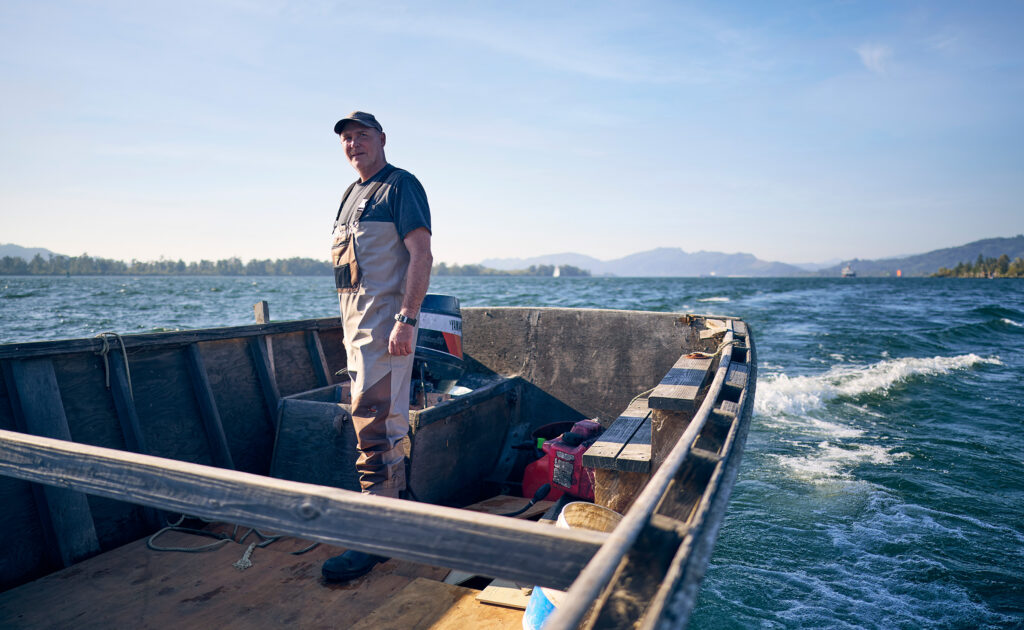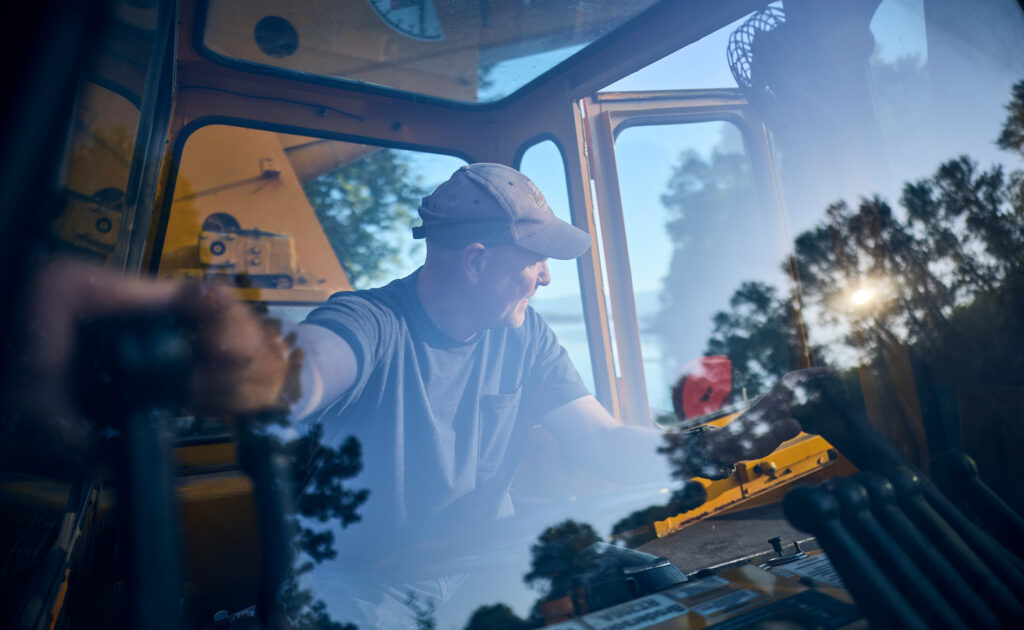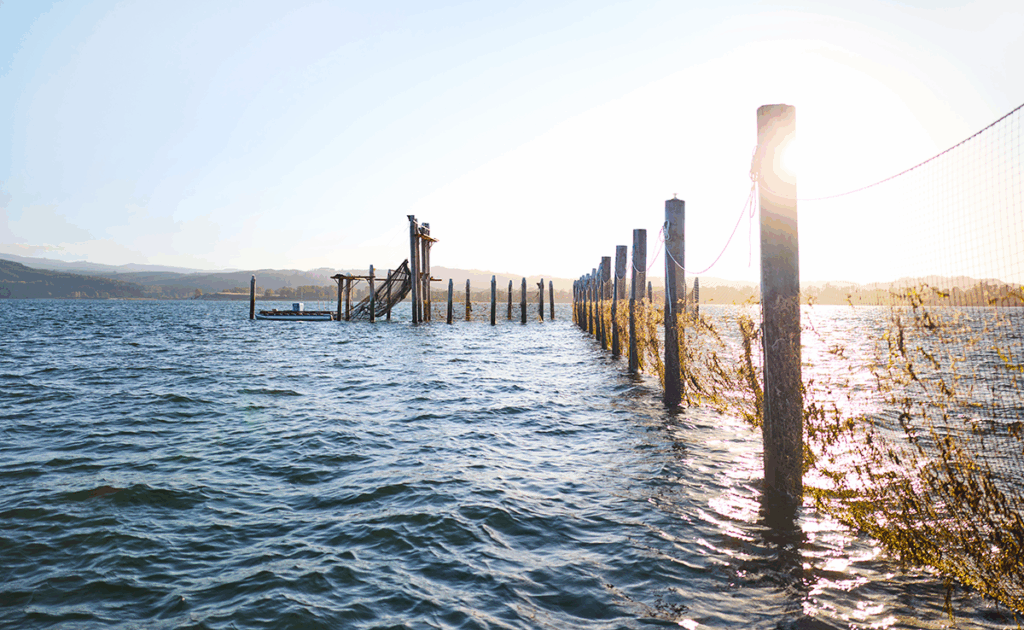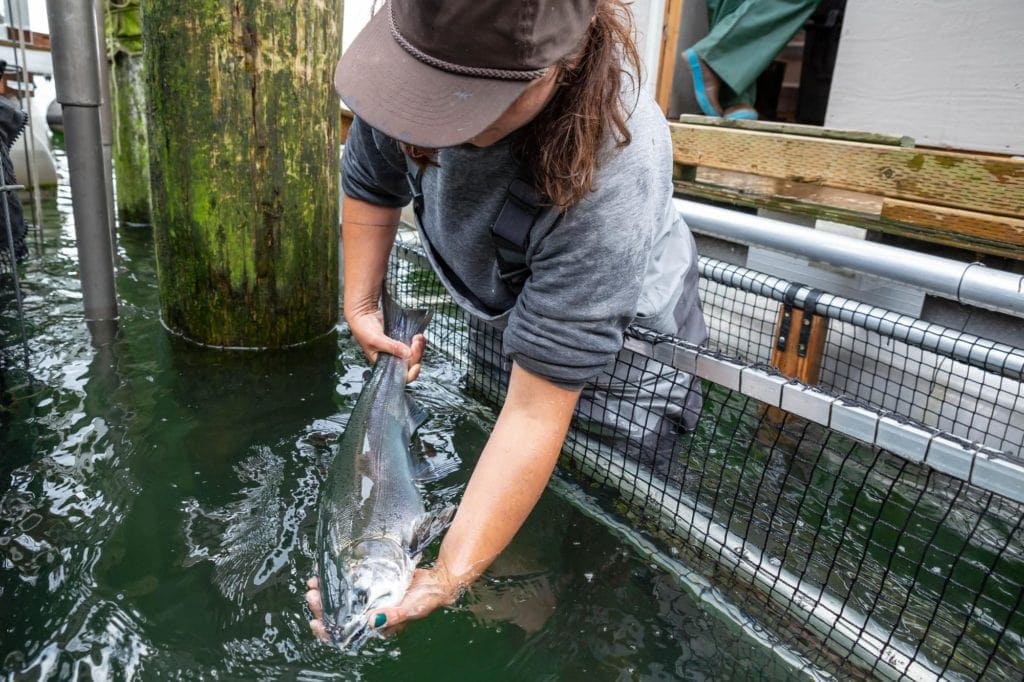
Earlier this year, Wild Fish Conservancy (WFC) proudly announced the implementation of Washington State’s second commercial fish trap since 1934. The new trap is part of the state’s historic Emerging Commercial Fishery—the first of its kind in nearly a century. This new site near the Hunting Islands represents our most recent collaborative experiment on the lower Columbia River to advance and improve selective fishing to reduce bycatch mortality, protect wild salmon populations, and benefit Washington’s rural fishing economies.

Figure 1: Drone footage of the Hunting Islands fish trap on the lower Columbia River. Photo by Mac Holt.
It has been a long, challenging journey for WFC and its partners to bring this experiment on the lower Columbia River to life. Permitting and grant applications for the fish trap project began over five years ago, in 2020. The project’s implementation was made possible by a state award from the Washington Coast Restoration and Resiliency Initiative, which is managed by the Washington Recreation and Conservation Office. A highly prestigious national award through the National Oceanic and Atmospheric Administration Bycatch Reduction Engineering Program later supported the final phase of implementation in 2024–2025.
With the Hunting Islands fish trap project now implemented and the research ongoing, it’s easy to forget the many challenges we faced bringing this project to fruition. From the beginning, WFC and our fishing partners navigated a stiff political current and numerous obstacles in our efforts to permit the new fish trap and advance critical research on alternatives to conventional gillnetting. In short, the project was delayed various times between 2021–2023 due to permitting and the likely influence of industry on our state and federal government agencies.

Figure 2: Wild Fish Conservancy staff member Devin Rose observing the livewell at the Hunting Islands fish trap. Photo by Mac Holt.
In the face of these major obstacles, WFC and its partners persevered to secure all local, state, and federal permits for the new fish trap project in 2024. We were thrilled to see pile-driving begin at the Hunting Islands fish trap site in December 2024. With planning, engineering, and oversight provided by WFC staff, all untreated wood piles were successfully installed, providing the framework for hanging and anchoring the fish trap nets ahead of the historic first year of the experimental fishery in August 2025.
Working closely with our local fishing partners, WFC’s team played a pivotal role at every step of the implementation process for this new fish trap project. Over the spring season, WFC conducted surveys of the pilings to secure precise measurements for development and construction of the fish trap nets. Our skilled welders and handypersons built custom livewell docks designed to passively capture and hold salmon for selective harvest or release, while our certified divers secured anchoring points for the nets at the base of each piling, working at depths of 25 feet or more on the Columbia River bed.

Figure 3: Commercial fisher Mike Clark operating the fishing skiff at the Hunting Islands fish trap. Photo by Mac Holt.
Over the summer, our technical experts worked hand-in-hand with local fishers to hang and deploy the custom-built nets, rig the winches, and troubleshoot initial operations at the new Hunting Islands fish trap. With the fishing gear up and running in August, WFC’s team has remained active supporting the fishers as they adapt to a fishing technology that differs dramatically from conventional gillnets.
This September, we were thrilled to see our hard work and perseverance pay off. The Hunting Islands fish trap has allowed progressive local fishers to selectively harvest hundreds of hatchery Chinook and coho salmon while safely releasing all wild salmon and steelhead without mortality. The trap has performed exactly as designed, providing a sustainable means for fishers to passively corral salmon and live-sort their catch without entanglement, air exposure, bruising, crushing, scale loss, or physiological stress. All selectively harvested fish have been of exceptional quality, allowing fishers to secure price benefits. The Hunting Islands trap has also proven to be the most productive and efficient gear we have engineered to date, outperforming the other two Columbia River fish traps in Cathlamet Channel, Washington, and Clifton Channel, Oregon.

Figure 4: Commercial fisher Mike Clark craning out a tote of fish at the Hunting Islands fish trap. Photo by Mac Holt.
While functioning efficiently and harvesting a product of exceptional quality, the Hunting Islands fish trap and the emerging trap fishery offer a compelling model of sustainability for broader replication. The river-based location of the fishery and the gear’s unique ability to allow for live-sorting make it one of the most sustainable methods for selectively harvesting salmon along the West Coast.
To harvest sustainably, a fisher must know what river a salmon has come from, the species and stock being harvested, the health of each stock, and the potential impact the fishing gear may have on released bycatch. Very few salmon fisheries on the West Coast can check each one of these boxes. For the most part, fishers and fisheries managers operate non-selective fisheries with limited understanding of the fish populations they are harvesting in real time—especially in marine-based fisheries. Often, threatened wild salmon are incidentally harvested and sold, while bycatch impacts to other encountered species and stocks are unstudied and cannot be accurately quantified. This conventional management of non-selective, mixed-stock fisheries has led to overharvesting of weaker, less productive fish populations, resulting in extirpation and the loss of genetic diversity.

Figure 5: Wild Fish Conservancy staff member Allen Mitchell operating a skiff at Hunting Islands. Photo by Mac Holt.
With the new Hunting Islands fish trap and neighboring traps in the Columbia River Emerging Commercial Fishery, the fishers and fisheries managers involved know exactly which stocks are being harvested. Given the river-based location of the fishery and unique means of live-sorting the catch, only the targeted hatchery stocks of Columbia River origins are selectively landed and brought to market. Absolutely zero wild salmon, steelhead, or other non-target species are incidentally harvested in this fishery. All bycatch encounters are closely monitored and documented by fisheries managers, and post-release survival has been carefully studied and estimated. This provides fisheries managers a means to accurately quantify any potential impacts to the stocks that are encountered and released, enabling them to appropriately manage for the health and recovery of those fish runs.
By removing hatchery salmon in the lower Columbia River fish trap fishery, commercial fishers are also helping to reduce interbreeding between threatened wild salmon and hatchery fish on the spawning grounds. This helps address problems associated with hatchery production, protecting the genetic integrity of uniquely adapted wild salmon populations for long-term recovery. Altogether, the lower Columbia River fish trap fishers and fisheries managers can proudly ensure their operations are truly sustainable and contribute to the recovery of our region’s threatened wild salmon.

Figure 6: Looking down the lead at the Hunting Islands fish trap on the lower Columbia River. Photo by Mac Holt.
Seeing the success of the Hunting Islands fish trap in this historic first year of the emerging fish trap fishery has been an emotional moment for our hardworking staff at WFC. Years of painstaking effort went into challenging the status quo and putting this experiment to the test at a new location in the Columbia River.
Looking ahead, it remains our sincere hope that the agencies end their stubborn resistance to change, unwavering support for conventional industry, and efforts to quash innovation, research, and data collection for sustainable alternatives to gillnetting that can advance the survival and recovery of wild salmon. Despite the politics that stalled and nearly derailed this critical research, the performance of the Hunting Islands fish trap proves the wait—and the struggle to get us here—was worth it. Working against the current, our experiment has shown that a hopeful path forward exists for the future of wild fish recovery and the commercial fishing tradition.

Invest in the Future of Sustainable Fisheries
Since 2016, our members and supporters like you have made this work possible. To keep this historic fishery moving forward, build on the momentum that brought us here, and ensure this critical work continues, we’ve launched a campaign to raise $25,000.
Your gift today will:
Your support today is more than a donation—it’s an investment in the future of sustainable fisheries.
Wild Fish Conservancy is recognized as a 501(c)3 non-profit by the IRS and all donations are tax-deductible (Tax ID: 91-1451405).
Featured Image: Commercial fisher Mike Clark at the Hunting Islands fish trap on the lower Columbia River. Photo by Mac Holt.